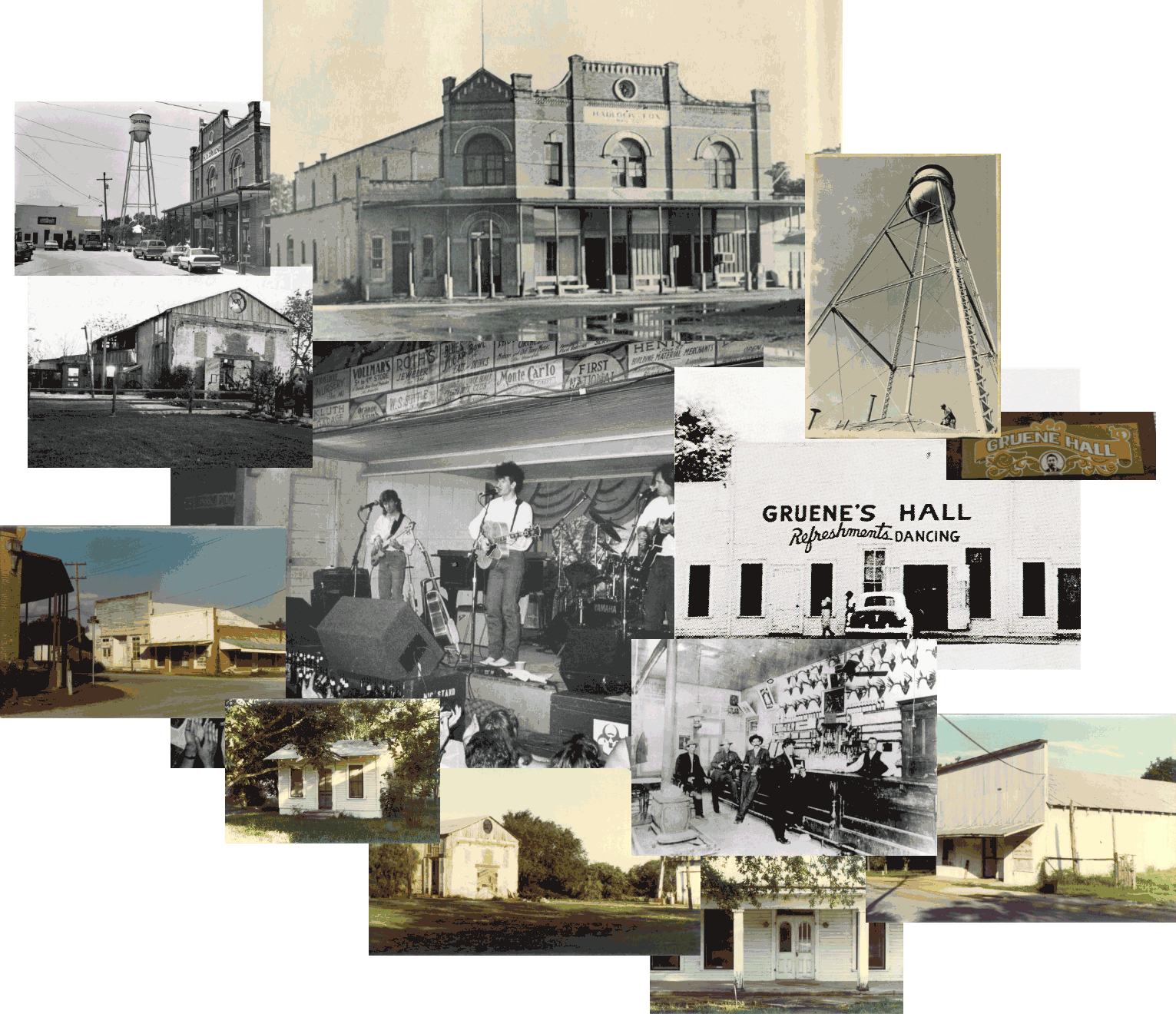
1845 | First Settlers
Arriving in Texas in the mid 1840s, German farmers became the first settlers of what is now known as Gruene, Texas.
1904 | Mercantile
As the town continued to prosper, a new mercantile building (now Gruene Antique Company) sprang up in 1904.
1974 | National Register of Historic Places
In 1974, Chip Kaufman, an architecture student at UT Austin working with the Texas Historical Commission and an avid kayaker, floated down a little further on the Guadalupe River than usual, to the southern most public takeout known as The Gruene Crossing. After catching a glimpse of an old water tower up the hill peeking above the treetops, he decided to investigate. Astonished by his discovery of numerous late 1800's and early 1900's buildings, some with architectural layering, he immediately realized their significance and requested permission from the Texas Historical Commission to inventory the buildings for their records, which they approved.
1987 | First Gruene Music & Wine Festival
The festival began as a one-day event with the purpose of celebrating Texas and Americana music while raising funds for the United Way of Comal County. In its inaugural year, the festival raised $450 for the charity. As the event has grown, so has the charitable give. So much so, that it is now proudly considered the highlight event for the annual United Way fundraising campaign in our area.
1878 | Dance Hall
Henry D. Gruene built houses in various styles — a Victorian cottage (now The Pomegranate), a large brick home, and a frame house (now Gruene Haus) for the foreman of his farm. The first mercantile store (now Gruene General Store) was built in 1878 and a cotton gin (now Gristmill River Restaurant & Bar) powered by the Guadalupe River was added soon after.
1922 | original cotton gin burned
The death of Henry D. Gruene in 1920 marked the downfall of Gruene's development and good fortune. In 1922, the original cotton gin burned and was replaced by a modern electric model down the road (now Adobe Verde).
1975
Pat Molak, frustrated with big-city life and in search of a true Texas dance hall, purchased Gruene Hall. A few unavoidable repairs were made to the Hall, but little else was necessary. Left uncorrupted, the 6,000 square-foot, open-air dance hall became a virtual magnet, a starting point for many of Texas' up-and-coming performers, and once again, the heart of Gruene.
1845 | First Settlers
Arriving in Texas in the mid 1840s, German farmers became the first settlers of what is now known as Gruene, Texas.
1878 | Dance Hall
Henry D. Gruene built houses in various styles — a Victorian cottage (now The Pomegranate), a large brick home, and a frame house (now Gruene Haus) for the foreman of his farm. The first mercantile store (now Gruene General Store) was built in 1878 and a cotton gin (now Gristmill River Restaurant & Bar) powered by the Guadalupe River was added soon after.
1904 | Mercantile
As the town continued to prosper, a new mercantile building (now Gruene Antique Company) sprang up in 1904.
1922 | original cotton gin burned
The death of Henry D. Gruene in 1920 marked the downfall of Gruene's development and good fortune. In 1922, the original cotton gin burned and was replaced by a modern electric model down the road (now Adobe Verde).
1974 | National Register of Historic Places
In 1974, Chip Kaufman, an architecture student at UT Austin working with the Texas Historical Commission and an avid kayaker, floated down a little further on the Guadalupe River than usual, to the southern most public takeout known as The Gruene Crossing. After catching a glimpse of an old water tower up the hill peeking above the treetops, he decided to investigate. Astonished by his discovery of numerous late 1800's and early 1900's buildings, some with architectural layering, he immediately realized their significance and requested permission from the Texas Historical Commission to inventory the buildings for their records, which they approved.
1975
Pat Molak, frustrated with big-city life and in search of a true Texas dance hall, purchased Gruene Hall. A few unavoidable repairs were made to the Hall, but little else was necessary. Left uncorrupted, the 6,000 square-foot, open-air dance hall became a virtual magnet, a starting point for many of Texas' up-and-coming performers, and once again, the heart of Gruene.
1987 | First Gruene Music & Wine Festival
The festival began as a one-day event with the purpose of celebrating Texas and Americana music while raising funds for the United Way of Comal County. In its inaugural year, the festival raised $450 for the charity. As the event has grown, so has the charitable give. So much so, that it is now proudly considered the highlight event for the annual United Way fundraising campaign in our area.
1845 – 1974
Arriving in Texas in the mid 1840s, German farmers became the first settlers of what is now known as Gruene, Texas. Ernst Gruene, a German immigrant, and his bride Antoinette, had reached the newly established city of New Braunfels in 1845, but acreage was scarce. Thus, Ernst and his two sons purchased land just down river, and Ernst built the first home in Gruene in early fachwerk style. His second son, Henry D. Gruene, built his home (now Gruene Mansion Inn) and planted his surrounding land with cotton. Having become the number one cash crop, the cotton business soon brought 20 to 30 families to Henry D.’s lands.
Henry D. built houses in various styles — a Victorian cottage (now The Pomegranate), a large brick home, and a frame house (now Gruene Haus) for the foreman of his farm. The first mercantile store (now Gruene General Store) was built in 1878 and a cotton gin (now Gristmill River Restaurant and Bar) powered by the Guadalupe River was added soon after. Further construction during this profitable time included a dance hall and saloon (Gruene Hall), which became the center of the community’s social life.
As the town continued to prosper, a new mercantile building (now Gruene Antique Company) sprang up in 1904. However, the death of Henry D. in 1920 marked the downfall of Gruene’s development and good fortune. In 1922, the original cotton gin burned and was replaced by a modern electric model down the road (now Adobe Verde). Yet, the economic disasters of the boll weevil and the Depression were too much for the family businesses and they went under, except for Gruene Hall, which never closed.
1974 – Today
In 1974, Chip Kaufman, an architecture student at UT Austin working with the Texas Historical Commission and an avid kayaker, floated down a little further on the Guadalupe River than usual, to the southern most public takeout known as The Gruene Crossing. After catching a glimpse of an old water tower up the hill peeking above the treetops, he decided to investigate. Astonished by his discovery of numerous late 1800’s and early 1900’s buildings, some with architectural layering, he immediately realized their significance and requested permission from the Texas Historical Commission to inventory the buildings for their records, which they approved. While doing this he learned that a group of real estate developers had purchased the last 200+ acres of the Gruene Estate, including all the historic buildings, and planned a housing development which included razing the old structures to build condominiums on the river bluff. Kaufman convinced the developers of the significance of the buildings in Texas history and with their blessing Kaufman worked to place Gruene on the National Register of Historic Places in 1975 as an entire district. The developers further agreed to let Kaufman find new owners interested in the old buildings for new commercial ventures which would provide a core for their new housing development. Pat Molak was among the first of the new owners.
Pat Molak, frustrated with big-city life and in search of a true Texas dance hall, purchased Gruene Hall in 1975. A few unavoidable repairs were made to the Hall, but little else was necessary. Left uncorrupted, the 6,000 square-foot, open-air dance hall became a virtual magnet, a starting point for many of Texas’ up-and-coming performers, and once again, the heart of Gruene.
With the help of his friend Mary Jane Nalley, he worked to preserve the authentic, turn-of-the-century look and feel of Gruene by purchasing and repairing several of the town’s most notable structures and transforming them into thriving businesses. These developments seemed to rekindle the spark of Gruene, and soon the town’s familiar charm began to shine again.
Gruene itself has been added to the National Register of Historic Places, and many of the buildings that were rescued by Molak and Nalley have been awarded a Texas medallion from the Texas Historical Commission. It has also been recognized by the Texas travel industry as a premiere attraction for visitors, which is no surprise to its merchants and guests.
Even with the remarkable growth of this once sleepy little town, the main focus of Gruene is, and continues to be, bona fide Texas. Everything from the wares they sell to the music they play speaks to Molak and Nalley’s commitment to preserving the authenticity of Gruene and providing its guests with an experience that has the signature seal of the Lone Star State.
